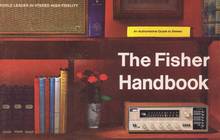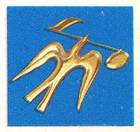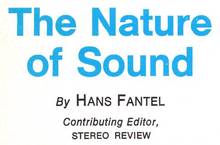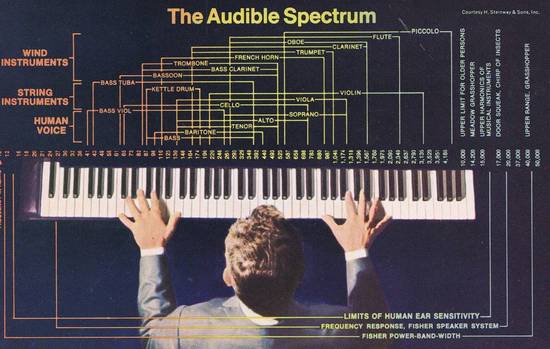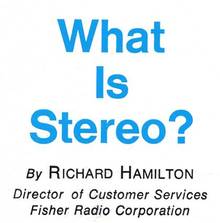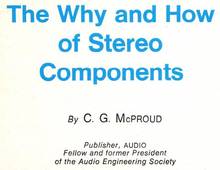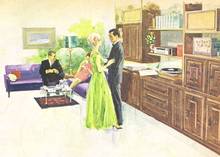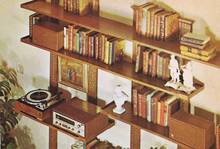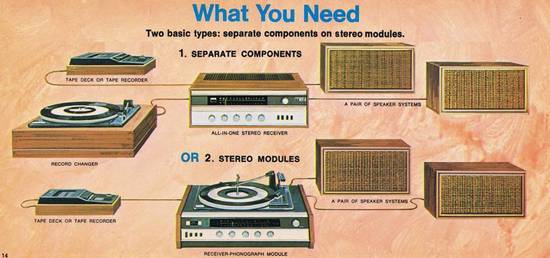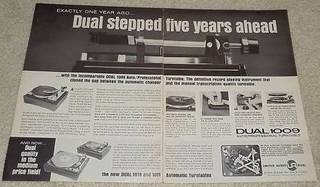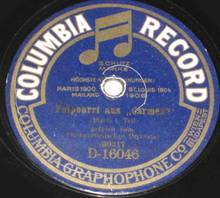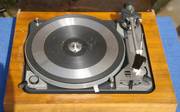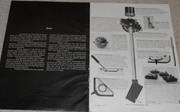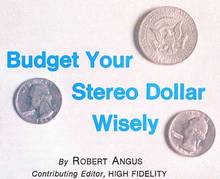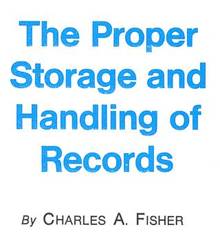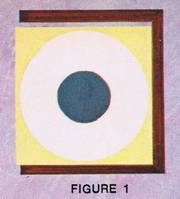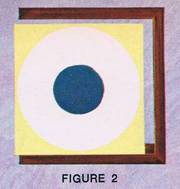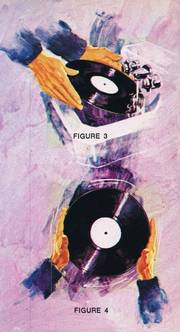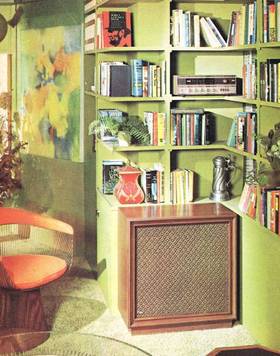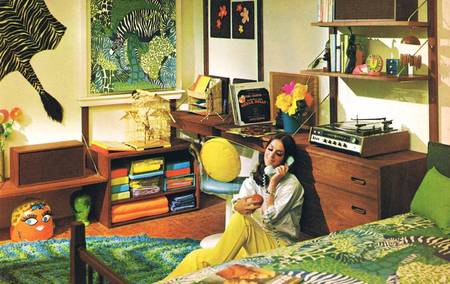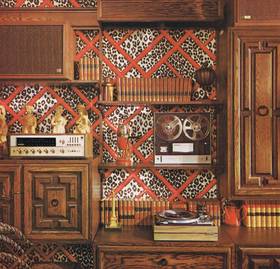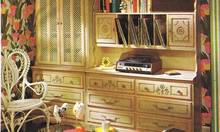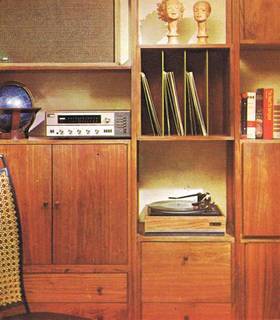1968 - Eine etwas keineres Handbook, dafür auch 72 Seiten
Die Branche steuert sehr schnell auf die "Hoch" -Zeit der Hifi- Blüte (etwa 1970) zu. Die Hersteller übertrumpfen sich mit neuen (Silizium transistorisierten) Modellen, neuen Entwicklungen (Stationstasten) und einer ungeheuren Vielfalt an Produkten. Und - dieser Prospekt, dieses Büchlein mit 72 Seiten ist jetzt bunt. Auch die Amerikaner sind anspruchvoller geworden. Fisher musste sich auch an den Markt anpassen. Die Super High-End Geräte verkauften sich ab 1967 nicht mehr so gut oder sie waren nicht mehr so gut - immer im Vergleich zum Wettbewerb.
Das Werben mit der größten Hifi-Fabrikationshalle Amerikas hatte nicht den gwünschten Erfolg. Auch unser Max Grundig warb damals mit der größten Tonband- und Musikschrank- Produktion Europas und später mit 33.000 Mitabeitern in 23 Werken jeweils mit "der Größte". Was ist übrig geblieben ?
Darum hier die englische Version aus 1968 : "THE FISHER"
Es sind 72 Seiten aufgeteilt in 2 Teile. Ein wenig Englisch ist ganz hilfreich. Im Falle eines Falles versuchen Sie den Google Übersetzer.
Das ist der Teil 1 der 1968er "The Fisher" Broschüre
-
A Word From Avery Fisher
As makers of high quality stereo equipment for the home our greatest pleasure must — and does — come from the creation of equipment that reflects all the best that the electronic engineering and industrial design arts have to offer. But for some years there has been another source of pride and pleasure for us — the publication and distribution of over two million copies of THE FISHER HANDBOOK. In preparing this publication we have turned to many of the leading authorities in the field of stereo, and home decoration. Their collective wisdom has made it possible to create a publication without equal anywhere in the world. THE FISHER HANDBOOK has helped music lovers everywhere to learn in nontechnical terms what stereo is all about. More important it has given them a sense of judgment as to which equipment is best suited for their purposes, and as to how it can most effectively be installed in their homes.
This latest edition of THE FISHER HANDBOOK, like its predecessors, offers an open door to the wonderful world of music in the home, an investment in pleasure that will keep on giving, literally, for decades. "Who hears music, feels his solitude peopled at once."
Avery Fisher, Founder and President
Fisher Radio Corporation
Der Inhalt der Broschüre - inzwischen auf 72 Seiten
.
4 The Fisher Tradition
5 The Nature of Sound, by HANS FANTEL 7 The Audible Spectrum
9 What Is Stereo?, by RICHARD HAMILTON
10 How Stereo Is Recorded and Broadcast
11 The Why and How of Stereo Components, by c. G. McPROUD
14 What You Need
15 How to Install a Stereo System, by RALPH FREAS
16 What Happened Since LP, by GODDARD LIEBERSON
18 Budget Your Stereo Dollar Wisely, by ROBERT ANGUS
20 The Proper Storage and Handling of Records, by CHARLES A. FISHER
22 Adding Music to the Room Scheme, by SHERMAN R. EMERY
26 High Fidelity Terms: A Technical Glossary
30 The Stereo Receiver
38 The Stereo Tuner
40 The Long and Short of Short Wave, by ROLAND GELATT
42 The Amplifier
44 How to Judge Amplifier Power in Watts, by RICHARD EKSTRACT
46 Technical Specifications of Fisher Receivers, Amplifiers and Tuners
48 The Speaker System
59 Technical Specifications of Fisher Speaker Systems
60 The Stereo Mods, by NORMAN EISENBERG 62 Fisher Music Centers
66 Audio Accessories 68 Who Owns a Fisher? 70 Fisher Firsts
.
The Fisher Tradition
IF A CROSS SECTION of serious music lovers were asked to list their requirements for a theoretically 'ideal' manufacturer of high-fidelity equipment, the chances are they would reply with a fairly accurate description of Fisher Radio Corporation.
They would undoubtedly want the head of the company to be a devoted music lover himself, preferably a trained musician, and most certainly an avid record collector. Avery Fisher is all threechamber music enthusiast, violinist, and owner of one of the country's major record collections as well as an usually rare and complete library of chamber music.
They would want the company to be deeply aware of every problem faced by the discriminating home music listener, of every major and minor trend in high fidelity, of even the slightest new development in audio engineering, and to have vast experience in translating this awareness into the finest equipment. Avery Fisher built his original high-quality radio and phonograph systems in 1937, as much for himself as for his handful of knowledgeable patrons, at a time when 'high fidelity' was strictly professional jargon and natural-sounding equipment designed specifically for the home desperately scarce. Since then, he and the Fisher Radio Corporation have been responsible for more engineering 'firsts' in high fidelity than the entire industry. (See complete list of Fisher Firsts on inside back cover.)
Today, in the age of stereo, Fisher components built in 1937 are still in use and the newest Fisher components are again considered by engineers and musicians alike to be the finest available in their respective categories.
One could draw many other parallels between the music lover's desires and The Fisher Tradition. The important thing, however, is that the Fisher Radio Corporation is as deeply steeped in music itself as in technical know-how and that each new Fisher component design, before it can go into production, must satisfy not only a staff of the most experienced audio and radio engineers to be found anywhere but also the ears of a man who knows what a real violin sounds like.
SINCE those early beginnings more than 25 years ago, some of the world's most prominent people — heads of state, royalty, leaders of industry and of the sciences and professions — have joined the roster of Fisher owners. Throughout the world, they represent the truest index to the meaning and worth of the Fisher brand name — the international synonym for high-quality sound reproduction. None of this, however, gives Avery Fisher nearly as much satisfaction as the fact that many of today's greatest musical artists choose Fisher equipment to hear their own recordings in their homes. The President of the Fisher Radio Corporation considers himself to be the firm's most demanding patron and he is pleased that his standards meet the most advanced musical tastes throughout all the world.
The Nature of Sound
By Hans Fantel - Contributing Editor, - STEREO REVIEW
IT IS ALL TOO EASY, in discussing the principles of sound reproduction, to take it for granted — and therefore lose sight of — the first requirement for high fidelity; something to be faithful to. Sound, after all, is not only the end product of high fidelity, but the raw material as well. The central purpose of a hi-fi system can perhaps best be described as the accurate reproduction of that part of the infinitely various world of sound that is used for the creation of music.
Take, for example, the matter of tone color — also called timbre — which contributes so significantly to the texture of music. A cello and a trombone may both be playing the same musical note, but the listener can easily tell them apart. What accounts for this?
When the great German physicist H. L. F. Helmholtz first began to analyze sound some one hundred years ago, he discovered that what the listener hears from an instrument as a single musical note actually consists of many different tones. There is, first of all, the basic pitch perceived by the ear — called the fundamental. But in addition to this fundamental tone, the musical note embodies a whole series of additional tones, called overtones or harmonics. These are multiples of the fundamental frequency (i.e., twice, three times, or four or more times the frequency of the basic note). Not all of these overtones are equally strong, nor do they have the same phase (time relationship to the fundamental). Each musical instrument has its individual overtone pattern and it is this pattern that gives each instrument the characteristic tone color by which we identify it.
Now, since hi-fi components must reproduce this pattern accurately if the sound is to be faithful to the original, it can be seen that a wide — and uniform — range of frequency response is necessary. Suppose an oboe is playing a note with a basic frequency of 1500 Hz.* Its overtones would be: 3000 Hz (1500 x 2), 4500 Hz (1500 x 3), 6000 Hz (1500 x 4), and so on. To do justice to the sound of the oboe, the system must reproduce these overtones in the exact strengths and phase relationships in which they occur in the original.
Even instruments such as the bass viol, the tuba, and the kettledrum — the lowest pitched instruments in the orchestra — produce higher frequency overtones that give them their particular tonal flavors. This accounts for the seeming paradox that a sound system must have a frequency range up to at least 15.000 Hz in order to reproduce instruments whose basic pitch is in the lowest octaves of the musical range.
Sounds are fast-moving areas of high and low air pressure — created by the "pumping" action of a sound source such as a plucked string, the vibrating body of an instrument, or the resonant action of an enclosed air mass. The air adjacent to these vibrating elements is driven back and forth, thus forming a series of pressure peaks and nulls that are first sensed by the eardrum and are then passed on and perceived as sound by the brain.
.
*Editor's Note; Hz is the technical term that has replaced cps (cycles per second) to designate frequencies. It commemorates the physicist Heinrich Hertz.
THE LOWEST SOUNDS audible to the human ear (the roll of distant thunder, for instance) have a frequency ot about 16 Hz. The lowest musical notes, such as the pedal notes of an organ, are in the vicinity of 30 Hz, although it is a rare musical note that falls below 50 Hz. A sound system with a bass response extending down to the 40- or 50-cycle range is therefore quite adequate for music reproduction.
The upper limit of human hearing varies with age. As a rule, only the young can hear frequencies above 20,000 Hz. The limit for adults usually lies around 16,000 Hz, declining with age (in most cases) to 10,000 cycles or less. No musical instrument has a basic pitch higher than about 5000 Hz.
But music played on a radio or phonograph that is limited to a top frequency of 5000 Hz sounds stripped of tonal richness — and it is, for the overtones that lend each instrument its characteristic tone color fall mainly in the 8000 to 15.000 Hz frequency range. A frequency response that extends to at least 15,000 Hz is therefore essential if the reproduced sound is to bear any relation at all to the original.
In addition to pitch and timbre, each musical note also has a certain loudness. And this, of course, means that there is yet another basic requirement for high fidelity equipment; it must be able to render different loudness levels in natural proportions, doing equal justice to delicate pianissimi and to riotous orchestral outbursts.
To many people the notion of music running through a wire seems quite uncanny. Indeed, the transformation of physical energy (sound) into electrical energy - and back again - is a marvelous process, although it is a commonplace event that happens - to give only one example - every time we speak into a telephone. If you really understand the relationships between physical sound and its corresponding electrical and mechanical expressions, you have the key to the mystery of audio sound reproduction.
.
What Is Stereo?
By Richard Hamilton - Director of Customer Services Fisher Radio Corporation
IT should be noted at the outset that stereo is not a new development which has somehow replaced an older technique known as high fidelity (or 'hi-fi'). Stereo is 'hi-fi', in its newest and finest form. Where earlier 'hi-fi' techniques used single channel reproduction, stereo uses two channels, each with unidentical information. It is these differences between the channels that create the stereophonic effect — the element of dimension that was missing from 'hi-fi'.
.
Stereo differs from the older methods of sound reproduction in that it recreates the space where the original sound occurred, as well as the other important characteristics of the sound. Before the advent of stereo, great strides were made in reproducing timbre (the exact shades of tone color) and dynamic range (the contrast between loud and soft), but the reproduction still lacked dimension — there was no distinction between left and right, up and down, front and back. These spatial characteristics can now be restored to the reproduction by means of the new stereo techniques, so that reproduced sound retains not only its original quality and individuality but also its original acoustic environment: it has the elements of direction and depth.
Let us consider an actual, live listening situation, such as a concert. The sounds that reach one's left ear are slightly different most of the time from those that reach the right ear. Instruments playing to the left of center are heard by the left ear a fraction of a second sooner than by the right ear. Conversely, it follows that instruments to the right of center are heard sooner by the right ear. The sound of instruments playing in dead center is heard by both ears at exactly the same instant.
These differences and similarities in arrival time enable us to distinguish the direction of each sound. The sounds reflected from the walls of the concert hall by reverberation reach one's ears slightly later than the direct sound, and this information is also sorted out in the same fashion by both the left and right ears. Combined with the differences in loudness between near and far sounds, these directional 'echo' effects help us judge the size of the concert hall as well as the distance between each of the instruments.
.
The Why and How of Stereo Components
By C. G. McPROUD - Publisher, AUDIO - Fellow and former President of the Audio Engineering Society
IF you understand the basic concept of high fidelity, you are ready to take a look at the 'hardware' necessary to provide a working system, and that is where you have to start making decisions.
The three common sources of program material — radio, phonograph, and tape — all require different kinds of devices to implement their various functions, but every high fidelity system will have some form of amplifier and some form of loudspeaker.
The Amplifier
The purpose of the amplifier is — simply enough — to amplify. All of our sources of program material provide signals which are not nearly strong enough to operate a loudspeaker. From a phonograph record, we get a signal of approximately 2/1000 of a volt via the cartridge, which is the device that translates the modulations of a tiny groove into an electrical signal. From the radio station we pick up a signal measured in millionths of a volt, and from a reel of tape the signal is likely to be just about a thousandth of a volt. Each of these signals must be boosted in strength to drive the loudspeaker. In addition, to provide properly balanced sound from the speakers, the proportion of bass and treble in the signal must in certain cases be changed according to a standardized formula; we call this process equalization. The common tone control is another form of 'equalizing' familiar to everyone.
The Loudspeaker
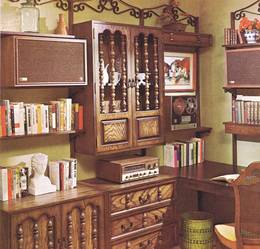
- To obtain the stereo effect, speaker systems should be separated by a minimum of six feet, as shown in this compact installation. Eight to twelve feet of stereo separation is recommended for best stereo listening pleasure. In larger rooms, where as much as 20 feet of separation is desired, it is best to connect a center channel or 'third' speaker system. This unit will fill the aural 'hole in the middle' between left and right speaker channels that usually results from overly wide separation. In certain cases, a voltage-derived center channel output must be fed into an extra power amplifier. Most highpowered Fisher Receivers have a power-derived center channel at the rear of the set in addition to connections for left and right speaker systems.
In most cases, the loudspeaker is the only portion of a high fidelity system you will find separately enclosed in some form of 'furniture.' Acoustically, the cabinet or enclosure is a very important part of the loudspeaker system, and it is well recognized that a loudspeaker unit of the highest possible quality can have its performance completely spoiled by being placed in a poorly designed cabinet.
Almost any loudspeaker works fairly well in the midrange frequencies — say from an octave below middle C to three octaves above middle C. It is the extremes that become difficult to radiate into the air.
A loudspeaker must move a lot of air to perform properly at low frequencies, and consequently the woofer — that's the unit that handles the low tones when two or three separate units are employed — is usually fairly large and with a heavy cone structure; whereas in a unit designed for the midrange only, the cone will be smaller and lighter. For the very high tones, the tweeter unit used is sometimes of horn construction; or it may have a tiny and light radiating area, often in the form of a hemisphere.
Selecting a loudspeaker is a personal problem. Tastes differ among people — what one individual likes may not be acceptable to another. While it might seem that there could be a 'perfect' loudspeaker, we must admit that not even the finest products of different manufacturers sound alike: and since each manufacturer must theoretically be doing his best to achieve quality, the buyer has plenty of room for choice.
Anmerkung: Ein typisches Marketing Foto aus einer amerikanischen Musterwohnung der 1960er Jahre. So konnten Stereoanlagen nie Stereo wiedergeben. Die Boxen über Eck positioniert, einfach voll daneben. Doch das kam leider bei Grundig und in anderen deutschen Prospekten - also auch bei uns - vor.
.
The Tuner
If you have elected to use radio programs as part of the source material for your high fidelity system, you will need a tuner. Everyone is familiar with a 'radio set' in one form or another. While it would be possible to connect an ordinary radio set to a high fidelity system, it is rarely done because the average set does not have an electrical output of sufficiently high quality to feed into a carefully planned system. Consequently we add a high fidelity tuner to our amplifier and loudspeaker, and we can then enjoy radio programs.
There are two basic types of radio broadcasting in use today: AM and FM, standing, respectively, for amplitude modulation and frequency modulation. Both have their uses, but FM offers somewhat higher quality, including a greater dynamic range, from pianissimo to fortissimo, and a wider frequency response, from the deepest bass to the highest overtones. In addition, FM is much less susceptible to atmospheric noise and 'man-made' static.
The Receiver
The tuner and the amplifier are today generally combined into one unit known as a receiver, which performs all the functions of both, yet requires only one cabinet and one power supply, resulting in considerable savings to the user. With modern solid-state design, less heat is generated and less cabinet space is required, but both units perform just as well as though they were separate.
The Record Player - (jetzt mit Dual 1009)
This term is inclusive in that it encompasses a number of vastly differing devices. One is, of course, the mechanical unit which rotates the record, and this may be a turntable or a record changer. (The latter is now more often called an Automatic Turntable.) The device which actually contacts the record groove is called the Stylus, and it is an integral part of the Pickup or Cartridge. The cartridge is mounted on the Arm (or tone arm). It is the cartridge that converts the mechanical motion of the stylus tip into a minute electrical signal, which is then amplified by the preamplifier. The arm guides the cartridge across the record in an arc that provides optimum stylus-to-record contact.
In the realm of the record rotating device, one must look for low values of wow and flutter, which are the names given to slow and rapid variations in turntable speed; and one must look for a minimum of rumble. The early hi-fi enthusiast generally preferred the turntable to the record changer, but in recent years the automatic turntable has been so greatly improved that today there is little difference in most cases. The automatic has the advantage of being able to play several records in sequence without attention, while the manual turntable needs attention at the end of each record.
Anmerkung: Dual war mit dem Dual 1009 und dem Dual 1019 innerhalb kürzester Zeit auf dem Weltmarkt - also nicht nur in Amerika - der Referenz Player - DUAL wurde in den USA das Synonym für einen analogen Plattenspieler - sogar heute noch in 2012.
Das war natürlich ein Afrront für den deutschen Distributor - die Amis nahmen keine ELAC laufwerke, sondern den oder die vom Wettbewerb, der dem eigenen Unternehmen (ELAC) sowieso schon so viele Sorgen machte. Dual hatte alle anderen ehemals bekannten Laufwerks-Hersteller fast in die Bedeutungslosigkeit gedrängt.
.
The Tape Recorder
To the uninitiated, Tape Recorders all seem to look alike — that is, they generally have two reels and a number of knobs. To a certain extent, they all do about the same things, too, but there the similarity ends. If you are buying your first tape recorder, you should probably consult a really knowledgeable recorder specialist, describing the use to which the unit is to be put, the type of program material you wish to record, and so on. Some users want a machine only to play recorded tapes, as one would play phonograph records, so their machines can be considerably simpler. Perhaps your needs can be served best by one of the newer cassette machines, which are easier to use, since they do not have to be threaded as does the conventional reel-to-reel tape recorder. Cassettes are small — 2 1/2 x 4 x 1/2 inches — play up to half an hour on each side, and are simply snapped in place and are ready to play. They are available in both mono and stereo models, some with playback function only, and some which will record as well as play tapes. None compares in quality with a good 7 1/2-ips reel-to-reel machine, but they are most convenient.
It will be apparent at this point that all of these individual high fidelity components can be put into one piece of furniture to provide an entertainment center, but this becomes a large unit which must usually be fixed in its location in the average home. In many instances, this will be the preferred solution from the standpoint of decor. On the other hand, however, separate components can be placed on shelves, built into music walls or any other suitable space within the home, or simply put on appropriate tables. It all depends on your personal preferences. One thing is certain — a component high fidelity system is the one sure answer to your desire for superb musical reproduction in the home.
What You Need
Two basic types: separate components on stereo modules.
Your stereo system should be capable of reproducing the musical program from records, AM, FM, FM-Stereo broadcasts (and tapes if desired). Of all types of stereo equipment available, the two most popular are the Receiver-Speaker System and Module types, illustrated below. The Stereo Receiver combines all the functions of Tuner, Amplifier and Preamplifier on one integrated chassis.
.
All you require is a pair of good quality speaker systems for immediate musical enjoyment. By adding a record changer, tape recorder or tape cassette, you can extend your listening enjoyment through other forms of program material. The module system is a fully integrated Receiver-Phonograph on one chassis with two acoustically-matched speaker systems capable of wide stereo separation.
.
How to Install a Stereo System
By Ralph Freas -
High Fidelity Columnist, AMERICAN HOME
PUTTING a component music system together
is almost as easy as adding an extension cord to a lamp. One unit is linked to another with signal-carrying or power-carrying cables. But there's a right and wrong way of doing it.
The first thing to do after unpacking your unit(s) is to put the warranty card in the mail. No, nothing's going to go wrong. The warranty card is simply a bit of free insurance. It assures you of free service — so use it.
Two Cardinal Rules
Now, to business. Where will you locate your amplifier or receiver controls? Let's establish a Rule of Two.
The first rule is: Ventilate Adequately. The second: Consider Convenience.
- Anmerkung: Für die alten Röhrengeräte - teilweise für die alten Transistorgeräte auch noch - muß die Belüftung stimmen und für den Bediener / Hörer die Bequemlichkeit.
Adequate ventilation did not precede Rule Number Two through any whim on my part. It's important. Heat is the greatest enemy of all electronic equipment. It causes the deterioration of tiny electronic parts and, while the lessening of sound quality is not a dramatic one, it speeds the aging process that ultimately leads to lower fidelity of your equipment.
And now, Rule Number Two. One of the virtues of component high fidelity is flexibility of arrangement. You'll get more pleasure from your music system if it's placed where it's easy to use. Locate controls where they can be operated without your having to squat, squint or do a handstand.
Connecting the Speakers
Next, hook up the speakers. Don't turn on the amplifier or receiver just to see if it works — until after the speakers are attached.
If FM radio is part of your system, you're ready to try it as soon as the speakers are attached. You can tune in nearby stations but you'll pull in more stations with greater clarity and fidelity if you attach an antenna first. The twin-lead antenna provided with your tuner or receiver is quite a performer.
Where will you place your speakers? In general, they should be placed to beam their sound to cover the greatest area of your listening room. There are no hard, fast rules about the distance between stereo speakers. All listening situations differ in dimensions and you can make your own rules. Actually, this is part of component high fidelity's fun. Try your speakers in various positions for maximum effect.
.
The Record Player
Locate the record-playing equipment — changer or turntable — as close as possible to the amplifier or receiver, for two reasons.
First, you can take advantage of the convenience receptacle on the back of the chassis; plug the record player info it.
Second, the leads from the turntable to the 'phono' inputs should be kept as short as possible. Extra-long leads are to be avoided; they can diminish signal strength and add to hum and noise.
.
Accessibility Is Important
Finally, build in your components in such a way that you can get at them, that you can take them out if needed. Suppose for example, that you want to add extension speakers for patio, terrace, kitchen or den. Doing so is extremely simple — if you don't have to tear apart a cabinet or even a wall to get to the back of the amplifier. The same is true if you want to change your record changer or turntable, if you want to add that tape deck, or if you feel the need of a high-powered antenna to pull in distant stations.
What Happened Since LP
By GODDARD LlEBERSON President, Columbia Records, Inc.
A COUPLE I know with an insatiable appetite for being "in" on everything were once described as "always the first to be second." This also describes a large part of the record industry, and in this respect, I suppose, recording companies are no different from those in any other field in which there is a bonus for originality. Some changes and "firsts" are revolutionary, while others are, inevitably, only momentarily fancies, and certainly there is no particular virtue in being first with anything unless, at the same time, a concept is introduced which leads toward some basic value beyond the mere fact of innovation.
The introduction of the long-playing record did just this, and the ensuing changes were profound, not only for the record listener at home but, I believe, for our listening habits in general. Some of these changes were so radical that they can best be measured by the fact that most of us have forgotten what they were.
Let me remind you of a few. There were obvious ones. More music was put on a 12-inch record—up from four minutes a side to between twenty-five and thirty minutes. The price of the same piece of music was cut almost in half. Later, the further refinement of stereophony was developed. Then there was the much more subtle change in repertoire. In classical music there was the overnight disappearance of the single record, the "O sole mio" hit, the violin single of Humoresque by Dvorak, the piano solo of Paderewski's Minuet in G.
There are some who might say, with justice, that we are well rid of this cliche. On the other hand, there are those who felt that these single records were instrumental in leading a large public into the armchairs of the concert hall. I don't think that was the case, but it did have this significance for the classical performing artist: The disappearance of the "single" made it more difficult to be a 'hit" artist.
With the LP, a change also took place in recording technique, as tape became the basic medium in the first step of making a record. It seems inconceivable now that at one time the record-maker had to shoot for a perfect, or at least good, four minutes and twenty seconds of music. Many artists are sensible enough to see that an inspired performance with mistakes is preferable to a no-error performance when the consequence is no hits and no runs.
But the greatest change — at least in its philosophical consequence for the art of music — has been in the concert repertoire, because here, I think, the phonograph record has been an influence that has altered, in a fundamental way, the whole of our musical experience. For the first time, it became feasible (if not in all cases economically viable) for the record companies to record complete operas, complete Broadway shows, the complete works of a single composer, or all of his works in one form.
In thinking back over the past history, one doesn't need the guidance of semantic philosophers to realize how meaningless are such words as "modern" or "contemporary." That these words signify different things to different groups of people and different people within those groups is easily demonstrated.
When I began at Columbia Records in 1939, for instance, and from then until the introduction of the LP record, the large general public quite clearly considered the late works of Debussy, and those by Ravel and Stravinsky (even those pieces we now think of as his early, very easily digestible music), as thorny modern music.
By the time LP records came along in 1948, we were ready to transfer to this new technique not only most of the standard symphonic repertoire, but a great number of records of contemporary compositions, particularly those in which the composer-as-per-former was involved. This meant Bartok, Stravinsky, Poulenc, Copland, Piston, Schoenberg, Villa-Lobos. There was also a growing number of recordings made by the great American orchestras of heretofore unrecorded contemporary works, including, in 1947, excerpts from Wozzeck.
I'm speaking here of contemporary music because it soon became evident that the new technique of the LP record had an enormous appetite, and, where previously three or four works a month may have been released, it now becomes possible, and even necessary, to release a great many more records with an ever increasing repetition of the "famous" works.
At the same time, it has been interesting to see how the availability of certain music through records, and possibly through subsequent broadcasting, has changed the whole character of the symphony concert program. I'm sure many can think of more interesting examples than I can give, but, just from memory, it seems to me that Sibelius has all but disappeared from symphonic programs, certainly when measured against the regularity with which his music was once played.
This is also true of the symphonic music of Franz Liszt, whose symphonic poems were frequently heard, as were those of Saint-Saens. And what happened to the music of Cesar Franck? No season seemed complete some fifteen years ago without three or four performances of his Symphony. This was also the case with Rimsky-Korsakov's Scheherazade and other of his orchestral works. Certain lesser composers seem to have disappeared altogether, perhaps to reappear in some other age, or, perhaps, to be gone forever.
Yet, I've learned to hesitate or to be cautious in making claims for the influence of recorded music, because, more often than not, changes of any significance in our musical culture are the result of a complex and highly variegated series of events, many of them quite outside the world of music.
But one thing is clear: The enormous amount of musical repertoire that is now available for listening (and the advent of record libraries, which has removed economic barriers) has, with very few exceptions, made it possible for anyone to acquaint himself with almost every facet of our musical history.
WHAT OF THE FUTURE? It may very well be that the phonograph record will be the only future of the composers. I say "may be," because a great deal will depend on what happens to so-called serious music vis-a-vis its public. As it now stands, it is becoming increasingly apparent that the composer wants less and less to depend upon an intermediary — that is, a performer, particularly the performer in the organized form of a large orchestra. Perhaps he has become disillusioned through the difficulties of having music performed by large organizations and is striving for a kind of self-sufficiency. At the same time, the composer seems more willing to abdicate some of his prerogatives and leave more of music creating to the performer, which is quite the opposite of the role played heretofore by the composer.
With the growth of either of these two factors, the only permanency that a composer may hope for must obviously come through recordings, either those of his own electronic music (in itself a recording) or, in the case of aleatory music, in the recordings of concerts of improvisation.
This is not my vision of the future, but for many it seems to be. For me, the word "record" still has its original meaning: more or less permanent availability of an aural event in time.
Condensed from an article in The Saturday Review
Budget Your Stereo Dollar Wisely
By Robert Angus -
Contributing Editor, HIGH FIDELITY
SHOULD you use a $75 cartridge with a $60 turntable? Will a pair of speakers that cost $150 sound right with a $250 amplifier? What about speakers priced at $500 each used with an amplifier costing half that amount? Isn't there any rule of thumb for the uninitiated?
There is, or to be more precise, there are - a few. To begin with, back in high fidelity's monophonic days, budgeting for a system was quite simple. Considering the three main building blocks - record player, amplifier, and speaker — you could assemble a well-balanced system by spending about equal amounts on each. The mono budget, in effect, could be figured as a simple ratio of 1:1:1.
Then came stereo, with the need for new and/or additional equipment - and the ratio was upset. Speakers cost no more than they had before, but suddenly you needed two of them. Stereo amplifiers did cost more than, but not twice as much as, mono units. And while cartridge prices went up slightly, turntable and record changer prices remained about the same. As dealers and the public got used to the idea of stereo, a modified version of the 1:1:1 ratio appeared - something like 1 (record player) : 1 1/2 (amplifier) : 2 (speakers). Until recently, this formula generally prevailed: that is, if you asked most owners of a high fidelity stereo system how they had apportioned their funds, chances are you'd learn that a little less than half of the total budget went for loudspeakers, the remainder divided between amplifier and different types of record-playing equipment.
It is now apparent that something new has happened to upset the revised ratio between record player, amplifier, and speakers— and that something is the stereo FM receiver. Until quite recently, most audiophiles considered stereo FM an adjunct to a home stereo system. By the end of last year, however, at least eighty per cent of all systems sold were based on a stereo receiver—a combination stereo FM tuner and stereo control amplifier on a single chassis. Obviously, then, a new formula is needed.
We can generalize on a new budget formula of 1:3:2 for record player, receiver, and stereo speakers respectively. As system prices go up, the percentage of the total spent on record player/ arm/cartridge can decline by as much as fifty per cent. At the same time, the speaker's share of the total may climb from about one-third to nearly one-half while the amplifier-tuner's share remains relatively constant.
But note that the relationship between speakers and amplifier can modify even the new formula. Acoustic suspension speaker systems have become increasingly popular in recent years. These low efficiency speakers require more powerful amplifiers to drive them than do higher efficiency speakers. Since the cost of an amplifier goes up as the manufacturer adds watts, you'll find that the efficiency of the speakers can affect budget proportions.
TO PUT IT ANOTHER WAY, there are two ways you can achieve a comparable level of sound volume and quality in your listening room. One is by using low efficiency loudspeakers with a high-powered amplifier; the other is by using high efficiency loudspeakers with a lower-powered amplifier. The buyer of a pair of low efficiency speaker systems may pay $400 for them, then need to spend another $450 for a receiver that includes an amplifier capable of providing the 25 watts per channel needed to drive them. His neighbor may like the sound of two high efficiency speakers costing $600 or a bit more; he may have to spend only $250 on a stereo receiver which will provide all the power - say, 15 watts per channel - he needs.
There have been dramatic changes in loudspeakers themselves which relate to budgeting. Until recently, most audiophiles considered $80 to $90 about the rock-bottom price for a loudspeaker system that could qualify as high fidelity equipment. In the past year or so, we've seen several speaker systems bearing price tags of $50 to $60 which produce genuinely good sound. In a city apartment, for example, a pair of these, with a quality receiver and record changer, could afford much enjoyment. But the cost of such
a system would differ from our basic formula.
Beyond the basic elements of a stereo system there are extras which should be budgeted for but about which it's impossible to generalize. Take, for instance, the FM antenna. It may cost you nothing (many manufacturers include with their receivers a folded dipole antenna adequate for FM listening in most urban areas), or it may cost as much as $150.
Some advice for the shopper who may be unfortunate enough to encounter an unscrupulous dealer. When a dealer sells you a $350 stereo receiver and a $100 automatic turntable complete with magnetic cartridge and base, and then proposes to sell you two loudspeakers for $50, the time has come to be suspicious.
There are such things as bargains in high fidelity, but speakers at $25 to $30 each that are capable of revealing all the purity of sound of a $350 amplifier-tuner combination are unusual, to say the least. (If you accept such an offer, or if you take advantage of one of the package deals in which two low-cost speaker systems are thrown in free with the purchase of a stereo receiver and automatic turntable, at least do so with your eyes open—knowing that you will later have to substitute better quality speakers in order to get the full potential from your system.) At the opposite extreme, a dealer may offer you a well-known receiver or amplifier of modest price, and then try to convince you that you must have a really fine automatic turntable and a pair of expensive speakers for quality results. Again, keep that 1 (record player): 3 (receiver): 2 (speakers) ratio in mind.
Most dealers will help you buy a balanced system. For your part, decide the total amount you want to spend before you walk into a shop—then spLend it judiciously according to the formula suggested here that best meets your individual situation. This way you can keep the salesman, and your budget, in line.
The Proper Storage and Handling of Records
By Charles A. Fisher
THERE are few things one can purchase that are capable of giving so much pleasure over a long period of time as a fine recording. It contains within its relatively delicate grooves the data that are brought to life as audible sound by your high fidelity system. As your collection grows it becomes the 'open sesame' to the vast and wonderful world of recorded music literature. Your records deserve, and will repay you for all the care you give them.
First, as to proper storage: All records should be stored vertically, never horizontally. Neat, vertical storage places all the weight on the record's edge, preventing warpage. In planning the storage shelves, it is best to have these of a depth of the average LP record cover (or approximately 12"). This will permit your records to overhang the front edge of the shelf, making it much easier to withdraw the desired record by grasping the top and bottom edges. (See Figure 1).
Anmerkung: Das mit dem Abwaschen unter der Wasserleitung ist natürlich die unglücklichste Form der Reinigung. Wie leicht schrammt der Laie mal aus Versehen an dem Wasserhahn entlang und damit ist die schöne Platte vollends futsch, dafür aber gewaschen.
.
Multiple record albums may require greater depth and it is more practical to construct the shelves deep enough to accommodate the largest albums, measuring from front to back, and then inserting the proper size cleat at the bottom rear of those shelves used for single record albums (Figure 2) so that these will still overhang the front edge by the same amount as deeper albums. The less clearance above the top of the stored records, the less opportunity there will be for dust to settle in this area.
Dust and oil, which are ever present in the atmosphere and on normal skin, are the greatest enemies of record life. Conversely, clean recordings played with a good quality cartridge capable of proper operation at low stylus pressures will, for all practical purposes, last almost indefinitely.
Cleanliness, from the outset, is easy to acquire (for most records are sold in sealed plastic covers), and as easy to maintain.
After opening a new record album, remove the record, holding it by the edges, not the recorded grooves. Hold the album cover open and blow vigorously into its interior. This will remove residual dust that may have found its way into even a new record cover. If this is done periodically, even records stored without plastic sleeves will be spared the scratches that come from dust trapped in the covers. Never leave a record on the turntable after it has been played, but blow on both surfaces to remove dust and store it immediately in its album.
Moderately dusty records can be restored to clean condition by an easy, no-cost method. Simply hold the record in your left hand under a stream of cold running water. Meanwhile, run the fingers of your right hand gently through the stream of water, across the face of the record, to loosen any dust that may be adhering to the surface. Avoid excessive wetting of the label. This is easily accomplished by inclining the record toward the faucet and rotating the playing surface slowly under the faucet, with the label just beyond the reach of the water. (Figure 3). After washing, briskly shake off the excess water and remove the final drops by running a tissue lightly across the surface. (Figure 4).
RECORDS that are heavily soiled can be restored to clean condition by careful washing in a basin of detergent water, followed by a clear-water rinse as described above. In both cases, one should avoid oversoaking the label.
We do not recommend the use of record cloths because dust inevitably trapped in these materials convert them, in a sense, to an abrasive. If rubbing is necessary to remove adhering dust, it should be done only in the presence of a good lubricant. (Running water is a splendid lubricant, when used under the technique described earlier.)
In summary, for the preservation of your record library, you will quickly find that there is no substitute for consistent and simple care, utilizing the methods noted.
Anmerkung zu den folgenden Bildern aus 1968
Die folgenden Bilder zeigen einen Einblick in die Wohnwelt der Amerikaner von 1968, aber auch in die Denke der Marketingleute. Es sind nämlich überwiegend Musterwohnungen aus Möbelhäusern. Diese Marketingmenschen haben dort manchen Unsinn verzapft. Vieles ist für Stereo unbrauchbar bis unmöglich und unbequem ist es ebenso.
.
In the early days of music reproduction, a phonograph meant an awkward contraption with a brightly painted morning glory horn attached. It was a curiosity, quaint to look at, and not too far out of place in the front parlor with its Victorian furniture and flowered wallpaper. Today the front parlor no longer exists. It has been replaced by rooms which we use, not just when company comes, but every day — living room, family rooms, playrooms. The music system has become an integral part of the room scheme rather than a novelty resting in the corner on a draped table.
.
Interior designers and homemakers introduce music in their homes in many ways. If they choose separate components, they can be incorporated into an existing piece of furniture such as a breakfront cabinet or commode. Since today's equipment is so well designed, it is frequently placed on open bookshelves or in wall units and arranged like accessories or objects of art. In fact, an intermingling of components and interesting pieces of art — sculpture, vases, pictures — can be an effective focal point.
Years ago, a professional hi-fi installation required the use of a separate tuner and amplifier in order to attain the highest quality of performance and flexibility. In many instances, a separate power amplifier and master audio control were considered essential. Today, the stereo receiver not only performs the functions of tuner and amplifier on one, beautifully integrated chassis, but outperforms the finest separate components.
Heart of this professional stereo installation is the Fisher 800-T, the world's finest AM-FM Stereo Receiver. Other components include a specially designed 2/4-track tape recorder, a 4-speed automatic turntable, and a pair of Fisher Speaker Systems. The quality of performance and flexibility of control in this relatively compact installation is as professional as it is possible to achieve, yet the beautiful styling of the components enhances the attractive decor of the room.
.
A new type of stereo component system, the Home Music Center, combines the functions of phonograph and receiver on one, integrated chassis. It is one of the newest and most popular stereo systems because it reduces space requirements to the barest minimum, without any sacrifice in the quality of performance.
ADDING COMPONENTS to a room may mean making a few changes in the existing furniture layout. Seating pieces may require rearranging to take full advantage of the optimum listening area, which means that part of the room where all the effects of stereophonic sound reproduction are heard best. Experiment on paper first by drawing a rough outline of the room. Then measure the major pieces of furniture and place them on the plan. (The best scale to use for this purpose is 1/4" to the foot.) Try several arrangements and then after you have found the one which looks best on paper, try it in the room. A little effort in trial and error will result in a room arrangement which is not only the best from a functional standpoint but esthetically satisfying as well.
This installation features the Fisher 250-T AM-FM Stereo Receiver with TUNE-O-MATIC® Pushbutton Memory Tuning—ideal for those who seek convenience, flexibility and fine performance. The 4-speed automatic turntable is in a separate enclosure. In this way, any possibility of acoustic interaction between speakers and turntable is eliminated.
.
.

